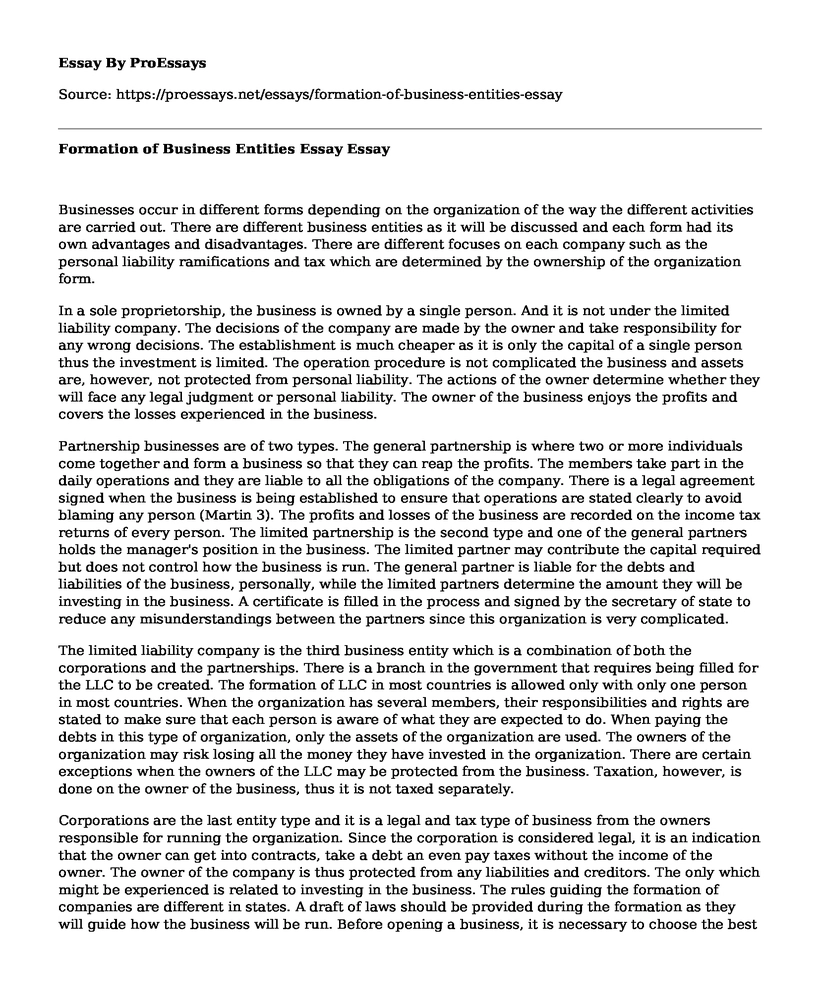Businesses occur in different forms depending on the organization of the way the different activities are carried out. There are different business entities as it will be discussed and each form had its own advantages and disadvantages. There are different focuses on each company such as the personal liability ramifications and tax which are determined by the ownership of the organization form.
In a sole proprietorship, the business is owned by a single person. And it is not under the limited liability company. The decisions of the company are made by the owner and take responsibility for any wrong decisions. The establishment is much cheaper as it is only the capital of a single person thus the investment is limited. The operation procedure is not complicated the business and assets are, however, not protected from personal liability. The actions of the owner determine whether they will face any legal judgment or personal liability. The owner of the business enjoys the profits and covers the losses experienced in the business.
Partnership businesses are of two types. The general partnership is where two or more individuals come together and form a business so that they can reap the profits. The members take part in the daily operations and they are liable to all the obligations of the company. There is a legal agreement signed when the business is being established to ensure that operations are stated clearly to avoid blaming any person (Martin 3). The profits and losses of the business are recorded on the income tax returns of every person. The limited partnership is the second type and one of the general partners holds the manager's position in the business. The limited partner may contribute the capital required but does not control how the business is run. The general partner is liable for the debts and liabilities of the business, personally, while the limited partners determine the amount they will be investing in the business. A certificate is filled in the process and signed by the secretary of state to reduce any misunderstandings between the partners since this organization is very complicated.
The limited liability company is the third business entity which is a combination of both the corporations and the partnerships. There is a branch in the government that requires being filled for the LLC to be created. The formation of LLC in most countries is allowed only with only one person in most countries. When the organization has several members, their responsibilities and rights are stated to make sure that each person is aware of what they are expected to do. When paying the debts in this type of organization, only the assets of the organization are used. The owners of the organization may risk losing all the money they have invested in the organization. There are certain exceptions when the owners of the LLC may be protected from the business. Taxation, however, is done on the owner of the business, thus it is not taxed separately.
Corporations are the last entity type and it is a legal and tax type of business from the owners responsible for running the organization. Since the corporation is considered legal, it is an indication that the owner can get into contracts, take a debt an even pay taxes without the income of the owner. The owner of the company is thus protected from any liabilities and creditors. The only which might be experienced is related to investing in the business. The rules guiding the formation of companies are different in states. A draft of laws should be provided during the formation as they will guide how the business will be run. Before opening a business, it is necessary to choose the best entity which moves with the needs of the business owner.
Negotiable instruments are the evidence or title documents which are used showing the debt position of a business through any money transfers that have been conducted. They can be recognized as the promise to pay or the unconditional orders and there are the bearer bonds, promissory notes, checks, bank notes, checks, certificates of deposit and drafts. There are three principles which attribute a negotiable instrument and these are the instrument subject matter which can be an asset or a property which is taken from the person transferring to the one receiving through endorsement or delivery; the acceptance of the instrument in good faith and for value and it is accompanied by a document to show that the item was received and in good shape; and if the transfer does not take place, a no notice of transfer requires to be presented to the liable party (Schwidetzky and Fred 17).
Conclusion
In conclusion, choosing a business entity is the first step towards establishing the business type that should be used. After the business and determining the source of funding, it is necessary to have the negotiable instruments so that they can guide all the transactions and the business owners can be aware of what is happening.
Works Cited
Martin, Rhett. Understanding Negotiable Instruments: A Guide for Undergraduate Business Students. Frenchs Forest, NSW: Pearson SprintPrint, 2005. Print.
Schwidetzky, Walter D, and Fred B. Brown. Understanding Taxation of Business Entities. , 2015. Print.
Cite this page
Formation of Business Entities Essay. (2022, May 15). Retrieved from https://proessays.net/essays/formation-of-business-entities-essay
If you are the original author of this essay and no longer wish to have it published on the ProEssays website, please click below to request its removal:
- Article Analysis: The Creation of Entrepreneurship Opportunities for People Who Are at the Base of the Economic Pyramid
- Procurement and Contract Negotiation Essay
- Discharged for Off-Duty Behavior Paper Example
- Essay Example on Asia and America: Top Economies & Markets for Business Investments
- Essay on Planning Your Future: Leverage Design Thinking, Entrepreneurship, & Innovation to Shape Your Career
- Essay Sample on The Keys to Becoming a Successful Entrepreneur: Risk-Taking & More
- XYZ Inn - Free Report Example







